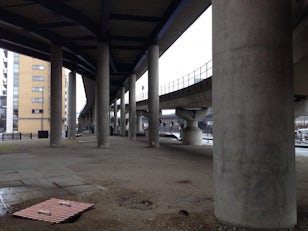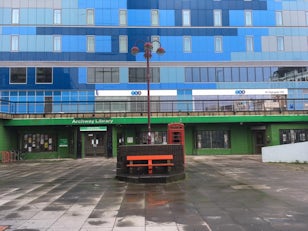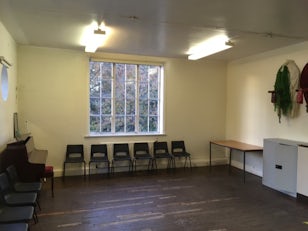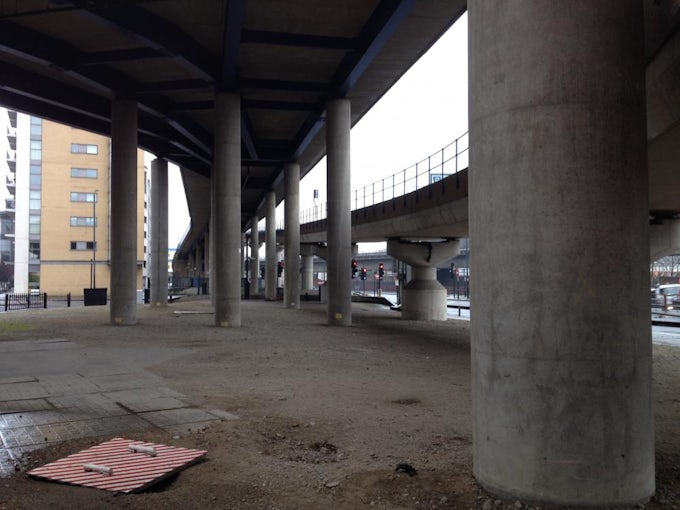
hmn is a quarterly sound-based test centre organised by artist Anne Tallentire and writer Chris Fite-Wassilak. This roaming event series, running since February 2015, is an intimate and unique platform for artists, thinkers and workers from a range of backgrounds to present new work. Conceived as an alternative space for testing ‘what sound is and can be’, each edition takes up residence for an evening in venues such as libraries and community centres across London. In a recent conversation with Beth Bramich, Tallentire and Fite-Wassilak discuss the project’s intentions and outcomes, and its ongoing development.
Beth Bramich: Can you start by telling me what hmn means or stands for? In the context of a ‘sound-based’ event, I have always thought of it as a kind of vocal filler but felt that in different cases it could be a break in the middle of an utterance, but also perhaps the moment before something is articulated.
Anne Tallentire: If it means anything, it’s like a hesitation, a space, a pause to think, perhaps. Something that buys you time, or makes a hole in time where nothing can occur, but the possibility of something occurring is perhaps suggested in that hmn.
Chris Fite-Wassilak: I think originally it started with this oral or sonic notion around it: we wanted to keep it as a multivalent vessel that could be everything and nothing, but that was also succinct and normal; a non-word that represented sound in a certain way without meaning anything specific.
AT: Yes, and the way you say it can change the meaning completely. You can say hmn to be affirmative, or hmmmn? as a question or hm-m-mn as a speculation. It’s got a lot of potential in it. Good luck with transcribing that. But I think that the moment before is also relevant because the name comes before the event so it’s what suggests the thing to follow it, it’s an invitation to join in some way.
BB: On that idea of the invitation, there are a set of rules that you have put in place which give the evening a distinctive feel.
CFW: Each participant has 7 minutes and there is no documentation. Those are the only hard rules. There are a few soft rules, like no clapping. We also have rules for participants in terms of trying to limit how much technology they use, trying to focus on ideas. And now I’ve started listing rules, we do have a lot of them! We have ones for ourselves: there’s a different venue every time, no galleries, no studios, and we put a cap on the amount of people attending at 45. But all of these rules are in place, paradoxically, to try to create a kind of parity between those taking part.
If it means anything, it’s like a hesitation, a space, a pause to think, perhaps.
AT: In a way, the rules for the participants, they’re not rules, and they’re not provocations either, they are part of the tenor of the invitation. Whether people present finished work or unfinished work, the sense is that it is propositional and therefore it is not the final major production. Obviously, something that is a proposition could involve lots of technology and infrastructure, but the way you could think about it is that we are sitting here in an informal situation talking about what we are doing in our work, and you say to me, what are you doing? And I say that I am making some installations that relate to whatever and describe it. Now without it being exactly that, it is in a way. It’s not about uttering the complete work at its final stage, it is a stage towards the final stage, and a very small one at that. There was also an expectation that people who would be interested in an invitation to attend something called ‘hmn’ would be predisposed to something that is not at the end of its making, but perhaps, on the way to it.
BB: One of the rules I find most interesting is that the audience is asked not to clap. Applause following a performance or spectacle is about release – you are led into something, you are engaged or emotionally involved, and then you applaud, and that noise is a finality. Why not let people have that release?
CFW: Yes, applause is a final punctuation mark – a thing has happened – and it’s a ready release. Telling people that it is 7 minutes, with no applause, helps set up a different expectation, or patience maybe.
AT: Our feeling was that holding that desire to let go until the end, or not at all, is that you hold the attention of the audience at a more acute level of, we are in this, we’ve become part of what is occurring here. I think the fact that it is structured around four people, four presentations, over one hour, these are the parameters. In total, we ask for one hour of people’s lives, plus a bit extra to come to the pub and to get there and leave. I also think there is a tendency in this very oversaturated world where there is so much to go to and so much one has to see, that consuming the right things at the right moment in the right way is a rule that we are all subject to. It varies according to whatever institution you are in, whatever bit of culture you’re consuming, but we have become inured to it. Sitting in the awkwardness of something that just doesn’t permit that release of, I’ve ticked that box, I can move on, that is what we wanted to sustain. It’s that level of attention. That was something different to, I have got this and now I will make my judgement and move onto the next thing. You defer that by holding that thought until you’ve been through the whole evening. So, playing with those expectations and structures is something we’re working with.
BB: You describe hmn as a ‘sound-based test centre’. We’ve talked about how the format as you describe it, with these seven minute presentations, might seem to lend itself to performance, but would you say that it is a platform for sound-based performance?
CFW: On the level of working with artists (although not just artists, whoever is taking part), we’re giving them the space to try out what they need to in a new idea. The use of ‘sound-based’ is more about how it frames the invitation being sent out beforehand. I also feel personally a little allergic to the ‘p’ word, so it’s more about finding a way of working that is time-based and event-based, and building a relationship between all the people in the space.
AT: What is really exciting is that each participant responds to the invitation completely uniquely, every single time. There is a level of exploration that is particular to their own experience as a practitioner, but also to their desire to test something they’ve not tested before. The fact that someone might for example read something to an audience doesn’t make it a performance with a capital ‘P’. Let’s say instead that the activity of reading in this forum might reveal the potential of that material and that work differently.
CFW: Yes, I think there is a hierarchy implicit in the word performance, of a delivery from a performer to an audience. It’s that hierarchy that we are trying to sidestep or avoid if we can. It’s more about a sharing of ideas, so the question is when and how an idea gets aired, and what is the moment of release.
AT: One of the things that we’ve talked about a lot, which is significant here, is that when you’re in the studio on your own trying something out you’ve got an audience of yourself, but the minute that someone comes into your space, be it one person, or two, three, perhaps a friend, a gallerist, or someone else, you hear yourself think and act differently. Now the space that is created between what you are doing and what happens when you are doing it in company is rich with potential. And that is what we’ve tried to structure. Hence the rules, and what that can become for people is infinite. 7 minutes of infinity… or infamy. That’s a really important part of it, as a practitioner at any level there’s a difference between what you do in private and what you do in the world, and there are masses of steps between one and the other. We’ve identified a step that has not been tested or harnessed.
CFW: A halfway house.
AT: Yes, a halfway house for ideas. It’s a lay-by in a way. Its parameters are porous and it is really important that it doesn’t institutionalise itself or become too fixed, it always lives in that interspace.

BB: This seems like a good point to talk about where the events take place. You work outside of traditional venues for art, and instead host the events in informal spaces like pubs, cafés and community centres. Is this because there is an idea that these are more accessible to the public? I ask because as I understand it the method of invitation is the mailing list, rather than working directly with a local audience, and so I wonder what this adds.
CFW: The sense of a publicness is important to the space we’re looking for, that it’s not closed-off and not exclusive or some high-end rented space. The majority of the spaces we work with are social spaces like community centres and libraries because they are just a completely underused resource that needs a broader audience. I don’t think we’re ever looking for a particular atmosphere from the architecture of the space itself, it’s more a certain dynamic. And we do have a mailing list, but we try to keep it growing. I don’t know if we can pretend it is entirely open, but it’s funny because that word accessibility means so many things, and there is this contradiction in these events of limiting numbers but also predicating this idea of openness and accessibility. But then total accessibility is perhaps a sort of fiction.
AT: I think one thing that is incorrect is that we are not open to the local public. On the contrary when we negotiate a space with a council, a library or a café, whoever we are dealing with will ask: can the people who use the space come to this event? And we always say of course and explain how it functions and ask them to get in touch with us if they want to come. It’s not that we actively say to the hosts of these spaces, we’re not going to have an arts audience, we want the people who use this space to come and experience this. It’s much more specific than that. The people who are custodians of these spaces are very aware of who might be interested and who might not. For example, when we did an event at Shoreditch Library at the time there were young interns, I think working on an arts project with the library, and they came and so did some of the library staff who were hovering around while we were setting up. So, there was actually a very meaningful facilitation for that constituency. That’s much more important than saying we are now a community-based art project that believes in total open access. We’ve found it’s much more productive to work in close relationship with the agencies involved. There’s not a binary between art and public in that way. We are the public.
CFW: I think both of us would agree with the idea of open access, but how do you create a porosity in the people who are coming and not coming? The idea of running an exclusive event makes me squirm, and I realise that 45 people is not very many, but what’s interesting is that part of it comes from who is taking part, each of them has different sets of people that they invite and then we also let people know through the venues as well. Each time there’s a mix of people who come every time and people who’ve never come before. And there’s a process that’s almost alluvial, by which I mean there’s an encounter between those who have attended before, who know the rules, and those who are being introduced. It’s not just local audience and art audience, I’m not interested in that contradiction as such, it’s more about people turning up, whether they’re involved in art or not.
BB: Could you expand on what is interesting about facilitating this type of encounter? I’m asking in particular about introducing something that might be alien, which could be considered rarefied or even exclusionary, but is also vital because of its experimental, playful, indeterminate nature.
CFW: The outdoors events have been really interesting, where the accidental witnesses have become part of it in a certain sense. When we were in Archway someone was on the platform overlooking the space and they asked, ‘What’s going on?’ And the artist Sophie Mallett responded, ‘I don’t even know how to start to explain that, but you can come down and have a look.’ Those who were familiar with art events just sort of clammed up, I felt myself do that too, because I didn’t know how to deal with this question. And as soon as Sophie answered in that way, it was just like, oh, this is a thing where people can come and go as they please. There were a lot of people passing by listening in on the pieces in that location.
If hmn is structured in such a way where there’s gaps for people to slip in and out, to have some chance encounter, then maybe something is working. Obviously, it’s an enclosed group, huddled there paying attention to something fragmentary or obscure, perhaps in public, but if there’s a possibility that someone outside might lean in, even for a moment, it helps cultivate that sense of the accidental and doubt as the beneficial by-products that hopefully we can create by doing this.
BB: As you’ve mentioned, you keep a strict cap on audience number. Why is this?
CFW: I think when it gets beyond a certain number of people it becomes a crowd, a group of people who are willing to disassociate or divest themselves of their presence in a place. So it’s trying to keep it to the point that people recognise it’s a gathering in a room or a space.
AT: And it starts around the participants. Each of the participants have the opportunity to invite their mother, their best friend, their gallerist, their neighbour, whoever they want, and to different degrees they take this up. And then we invite our mailing list, which as Chris said is constantly growing. I was so nervous about the last one, because I thought that we were going to be way oversubscribed for the size of the space. It is almost at that point.
BB: Can you talk a little more about the selection process?
CFW: We have a list of people we are interested in, and we try to stay open to those who might be interested or who would benefit; it’s never about who would suit it. In some cases we are familiar with what they do, and with others we have much less of a clue. We might have encountered them tangentially somehow, and we just ask them to take part. We’re interested in slowly growing an ecology that includes things that are alien to us. And it’s never thinking about who would work together. We ask people individually and if they can, great, and if they can’t, maybe they’ll do it eventually. There’s a little bit of luck and happenstance.
AT: It’s based on our knowledge of what people are doing and being sensitive to that, listening for, if you like, the moment in somebody’s practice where perhaps this could be useful. What’s interesting is the participants range from some very experienced people who have been practicing for quite some time and some that are younger or less experienced. Although on the whole, everyone to date has a fairly solid practice.
CFW: We see it as a professional opportunity. It has aspects of crits and mentorship and happenings, a mash-up of things that could be productive, but it’s also for people who have something at stake.
AT: That’s actually very important, we have the sense that each person is really engaged in what they do. And then we both bring different experiences to it in terms of what we do in the world and that synergy is quite useful, and our intergenerational experience is useful too.
CFW: We have different perspectives on things. From my own side, following a dissatisfaction with curating to feeling that the ecology in London didn’t support certain types of practices, it felt important to try to generate something that would provide support in a different way and to come up with different names. The aim is to try to avoid recycling the same things, trying to work together with people towards building something new.

BB: Was there a particular moment when you said to each other: there’s something missing, let’s make it happen?
AT: It came out of an experience that was quite fun, a launch event for my Copy Press book Object of a life which focused on presenting a response that Chris Fite-Wassilak and Lucia Pietroiusti made.
CFW: Yes, there were a number of small starting points, but the key one was when we worked together on the book launch, which led to a really lovely discussion. After that we talked more about my concerns with curatorial processes in London, and there was this shared desire for a space to think about doubt and hesitation productively. Asking how do we cultivate that, perpetuate it and hang on to it. Also looking at models such as ‘Foaming at the Mouth’ which took place in different venues across Dublin, or ‘Kammer Klang’ at Cafe OTO in London, where something really interesting was taking place.
AT: Chris is right to mention ‘Foaming at the Mouth’, which was an amazing initiative started by Tracy Hanna and Emer Lynch that happened in a pub in Dublin where artists could present work. It was very popular. The difference is in that scenario it can go on and on for hours and hours. I’d not been, but I’d heard apocryphal stories about it, and it just seemed to suggest that we could do something like that here, which might bring in people who might not normally be brought in.
BB: It doesn’t always feel open to engage socially after an event, but with hmn this is very much part of the structure. As someone new to the art world you might slowly learn that if you go to the pub afterwards that this could be an opportunity to ask a question of someone about something you have seen, but this feels very foregrounded in the shape of the evening.
CFW: Well feedback is built into the whole structure, the four participants have to meet up with us before the event and after the event, so that discussion is the point of the whole thing. It’s not just about the event, it’s about creating relationships and talking about things that happen together. I think that some of the people who have taken part have thought initially that they were being invited to give a presentation and then get feedback from the crowd. But actually, we try to take those moments that we really treasure of discussion and build those into the structure itself. So we invite people to move into a more casual situation that’s away from the thing we just experienced. Maybe this gives us some perspective, or maybe it doesn’t, but let’s hang out and talk about it. You have to just try to help create a situation within which people can share. It’s something that I feel we are still tweaking. We started booking tables to make sure people could hang out a bit more, but things get messy and spread out and they don’t always gel.
AT: Yes, we’re still learning. But it was like taking a tradition and saying there is something actually valuable in this, let’s just shine a light on it, look at it through a different lens. And it varies according to the event. One of the really productive and generative aspects are the contacts that people have made across disciplines, practices, geography. So, as Chris was describing with the alluvial sand, it also extends into this post-event moment when we’re in the pub talking with the participants. And Chris also has a great knowledge of pubs, so we try to find somewhere where we can hear each other and it also creates the potential for people to re-engage as you described with someone who has just presented, channelling the clapping into going to the pub. That was exactly what we hoped for in a way, for people to take all that and go and turn it into a few interesting ideas to share back.
The next event, hmn15, will take place on 10th December 2018, with participants Olivier Castel, Lucy Gunning, Daniel Schine Lee and Linda Stupart. For more information visit the hmnwebsite.
